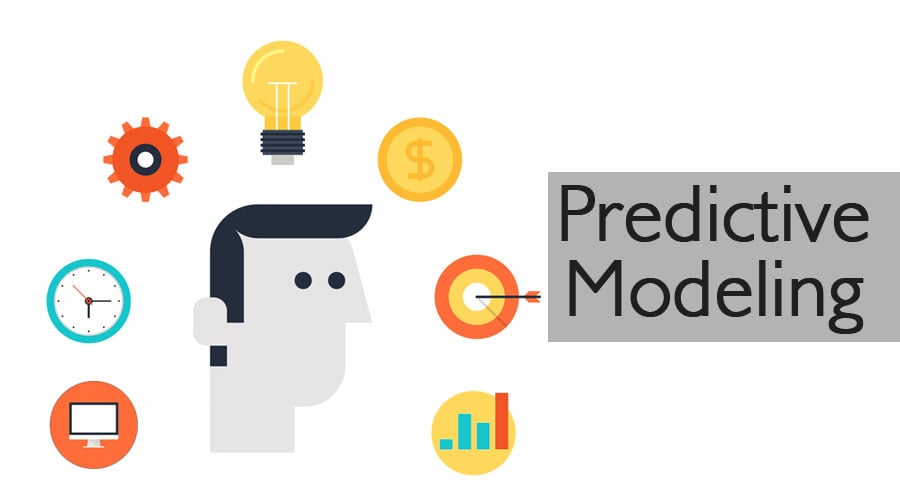Updated May 23, 2023

Introduction to Predictive Modeling
Predictive modeling helps determine accurate insight in a classified set of questions and allows user forecasts. It is serious about holding insight into outcomes and future events that confront key assumptions to uphold a spirited advantage.
Analytics professionals often use data from the following sources to feed predictive models:
- Transaction data
- CRM data
- Data related to customer service
- Survey or polling data
- Economic data
- Demographic related data
- Data generated through machines
- Data on geographic representation
- Digital marketing and advertising data
- Data on web traffic
Types of Predictive Modeling
There are different types of techniques of regression available to make predictions.
1. Descriptive Analytics
It is related to the data. For example, a Saas company puts up for sale of 3,000 licenses in Quarter2 and 2,000 licenses in Quarter1. Descriptive analytics respond to the query about total selling between these two periods.
2. Diagnostic Analytics
The reason for descriptive analytics lies in diagnostic analytics. From the above example, diagnostic analytics proceeds further with the data. It could also foresee whether the increase in sales is because of the performance of the sales persons or interest increase in a particular society.
3. Predictive Analytics
Predictive analytics exploit data mining and machine learning methods to forecast the future. Here the process involves looking at the past data and determining the future occurrence. Data analysts can construct predictive models on holding needed data. Predictive analytics largely differs from data mining because the concluding part spotlight is unearthing hidden relationships between these variables, while the previous relates a model to conclude a possible ending. A SaaS company might model data on sales of past marketing expenditures across every area to generate a forecast model for prospect income based on marketing spending.
4. Prescriptive Analytics
Prescriptive analytics tender a proposal based on a forecasted outcome. Relative to historical data can, action can be recommended.
Modeling Methods
The most widely used predictive modeling methods are as below:
1. Simple linear regression: A statistical method to mention the relationship between two continuous variables.
2. Multiple linear regression: A statistical method to mention the relationship between more than two continuous variables.
3. Polynomial regression: A non-linear relationship between residuals versus a predictor will lead to a non-linear relationship. This can be archived through a polynomial regression model.
Y = β0 + β1X +β2X2 + … + βhXh + ϵ
4. Support vector regression: Support Vector Machine is another regression method that characterizes the algorithm based on all key features. The Support Vector Regression (SVR) applies similar principles as the SVM for classification, with some minor differences.
5. Decision tree regression: A tree-like structure is used in these decision tree models to build classification or regression-related algorithms. Here the decision tree is incrementally developed by subsetting the given dataset into smaller chunks.
6. Naive Bayes: In machine learning, they are simple probabilistic classifiers predicted by applying Bayes theorem alongside independent assumptions.
i. Naive Bayes code snippet:
Code:
from sklearn.naive_bayes import GaussianNB
classifier1 = GaussianNB()
classifier1.fit(X1_train, y1_train)
# Predicting of the Test set results
y1_pred = classifier1.predict(X1_test)
Predict production rates and inventory. Also, production failures can be determined using past data.
ii. Competitive advantage over competitors, drumming into your customer data could present you with information about why the customers pick the competitor’s products; determining this data will help maintain an advantage over the customers.
iii. Risk reduction and fraud detection.
iv. Understanding customer expectations better.
v. Better marketing campaigns.
Advantages and Disadvantages of Predictive Modeling
Below are the advantages and disadvantages mentioned:
Advantages:
Production efficiency improvement allows companies to effectively use Predictive modeling processes, which imply statistics and data to foresee results with data models. These models enable forecasting anything from TV ratings to sports, technological advances, and corporate earnings.
Predictive modeling is another way termed as:
- Predictive analytics
- Machine learning
- Predictive analysis
Disadvantages:
- A practical gap exists with these prediction models while understanding human behavior.
- Decision models indirect power
- Polling prediction failure
Conclusion
Though considered a mathematical problem, predictive modeling always posts the expectation from the users to plan for the technical and organizational barriers that might prevent them from getting the needed data. And on a more significant point, this technique will be helpful in the analytics section of the data world.
Recommended Articles
This has been a guide to Predictive Modeling. Here we discuss the types and modeling approaches with their advantages and disadvantages. You can also go through our other suggested articles to learn more –

